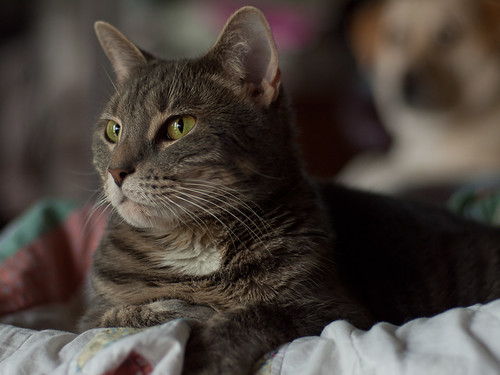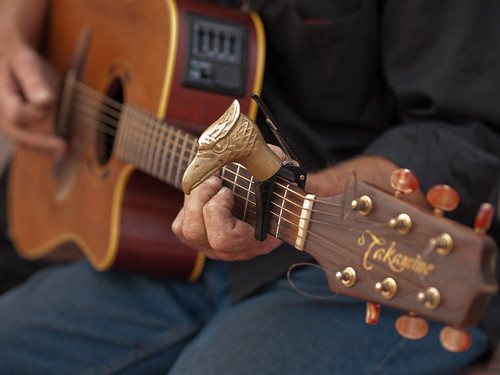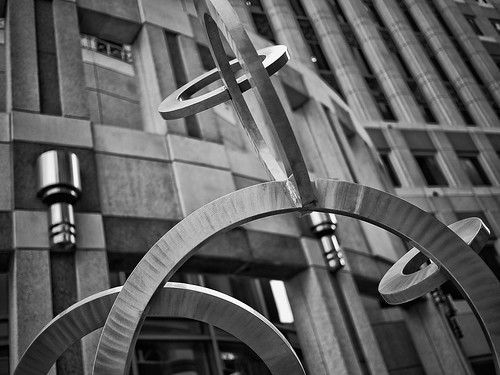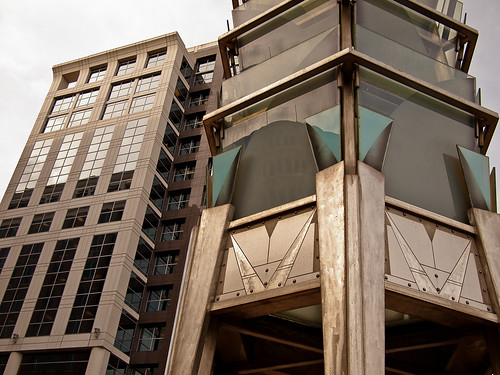Subject from Scene Separation and Fast Lenses on µ4/3rds Cameras
 |
| Olympus OM 50mm left, Olympus M.Zuiko 45mm center, Panasonic 20mm right |
Far too many forum photographers purchase fast lenses because of the 'bokeh' (the so-called 'quality of the blur') they produce when used at that lenses maximum aperture. This seems to have become something of a real obsession with the introduction of digital cameras, particularly with DSLRs. The ability to produce bokeh as well as its perceived quality is used as a discriminator between so called 'full frame' cameras and the 'lesser cropped' sensor cameras, especially the Olympus 4/3rds sensor-based cameras. It's been my personal experience, coming from a 35mm film background, that there's no appreciable difference between the smaller and larger sensor cameras, especially with lenses that can be opened up to f/2 or larger.
Until I learned of the term five years ago I'd never cared at all about how the out-of-focus areas looked in a photo unless they distracted from the subject and overall composition of the photograph. I looked at fast lenses shot wide open as a way to separate the photograph's subject from the rest of the environment, particularly in candid photography. The reason I want that kind of separation is to control what the viewer sees in given photograph. The less I can give the viewing eye to be distracted by, the better. The eye will wander over detail in focus far more readily than an out-of-focus area, even if it's a brighter area than the in-focus parts.
 |
| Lulu and Ruby - OM 50mm G Zuiko 50mm 1:1.4 at f/2 |
All of these photographs were made with my E-P2, which I purchased a good two years ago. When I purchased the E-P2 I also purchased an MMF-1 adapter to use my 4/3rds lenses to the E-P2 body. Two lenses in particular were two 4/3rds primes, the Zuiko Digital 50mm 1:2 macro lens and the Sigma 30mm 1:1.4. I already had an MF-1 adapter to use some much older Olympus OM lenses on my regular 4/3rd bodies (E-300, E-3), so it was only natural to put both adapters together to use those same OM lenses with the E-P2 body.
The first real OM lens I tried was the older G Zuiko 50mm 1:1.4 lens. It was first released with the OM-1 and OM-2 film bodies. It's distinctive looking in that it has a chrome ring effect around the front edge of the lens barrel and the front lens element has a gold-tinted multicoating. I used that lens, with the two stacked adapters, to shoot the photo of Lulu. And it was carefully manually focused.
Based on my experiences with film cameras I never shot a 50mm wide open, preferring to shoot a half to a full stop down from maximum aperture. The reason was very simple; depth of field. I preferred to have some additional depth of field to enhance my chances of capturing the subject's point of focus. In an age when you couldn't stop and 'chimp' the results, it was highly annoying to spend the day shooting, only to get back and find out after processing in the darkroom that the part of the subject I really wanted in focus wasn't. So I made it a habit to stop the lens down to increase my chances. So when I used the adapted OM lens to make the photograph of Lulu I fell into the same old habit.
Unlike the original OM film cameras, the E-P2 doesn't know how to handle old-style manual film lenses. When you pick an aperture you have automatically closed the lens down to the shooting aperture. This can be both good and bad. The god is see is literally what you get. The bad is the image gets darker, and under certain circumstances it interferes with focusing on the exact spot. Of course, stop a lens down far enough and you can use hyperfocal focusing techniques and then there's no need to fiddle with focusing.
I liked the photo above because I was able to focus on Lulu's eyes, and have enough depth of field to pick up her nose, wiskers, chin, and a bit of the surrounding head and ears. Yet the background focus drops off dramatically enough so that her profile is distinct from the background, even if you recognize Ruby in the upper left hand corner. Is the bokeh any good? I can't tell and I don't care, since to me the subject is quite in focus. Unless the out-of-focus areas are overly bright and causing a distraction the out-of-focus areas are irrelevant.
 |
| Quick-change Capo - M.Zuiko 45mm 1:1.8 at f/1.8 |
I've used kit lenses (such as the 17mm and 14-42mm) and adapted lenses pretty much the entire time I've owned the E-P2. Then, this past December, I purchase three lenses, two of which are considered fast native mount primes on the µ4/3rds systems, the Olympus M.Zuiko 45mm 1:1.8 and the Panasonic Lumix 20mm 1:1.7 primes. I'd read quite a bit about both lenses, nearly all of it good, and felt the need to purchase those lenses for the E-P2. And after two months of working with the lenses, I'm glad I did.
Both of those lenses can produce the same kind of subject separation from the background that the 50mm lenses I'd been previously using could produce. The 45mm (giving an equivalent 35mm focal length of 90mm) is probably the closest to producing the same separation effect as the OM 50mm (equivalent focal length of 100mm). But I can have that equivalency with a lens that's far smaller and lighter, and that will automatically focus with the E-P2.
 |
| Stainless Steel Urban Sculpture - Panasonic 20mm 1:1.7 at f/1.7 |
Not every lens provides the same effect of subject separation. Focal length plays a large part in the effect. Even though both the 45mm and the 20mm have essentially the same maximum aperture, the Panasonic 20mm can be considered a wide-angle lens, with over double the field of view of the 45mm. When the 20mm is opened up to its maximum aperture of f/1.7 and focused relatively close (in this instance, within about four to five feet), it can provide some degree of subject separation from the background to produce pleasing results, but not nearly as much as the 45mm, and as such demands more planning and compositional consideration.
The degree of separation isn't quite as dramatic with the 20mm as it is with the longer lenses, especially with the same camera-to-subject distance. If you're not careful in composition you wind up with too much distracting detail in the background, which the 20mm isn't quite as capable of "blurring out." Consider the photo of the urban sculpture. One of its primary flaws is the background, in particular the specular highlights on the the two outside lighting fixtures as well as the very flat reflection in the middle of the lower third of the photo. The foreground sculpture is already threatening to fall into the busy background as it is without the observer's eye having to 'fight' over landing on the three very bright spots of the photograph. Perhaps I should have used the 45mm and recomposed the shot, and I may go back and do that in the near future.
If anything, the 20mm is more the street lens, and should be used as such. Or if it is used for more formal compositions, then it should be stopped down one or two stops and used for architecture or other similar compositions, where you want a lot of clear detail through the photo, and a different style is used to present the scene.
 |
| Glass Asparagus, Downtown Orlando - Panasonic 20mm at f/4 |
Don't obsess over the parts of the photo you can't see. It's the part in focus that you should be paying attention to.

Good and strong images, Bill - loved the cat photo when I first saw it. And you have a nice collection of lenses. How I wish we had something like the 20mm for regular 4/3rds - but I understand that because of the larger flange distance, those are not easy to make.
ReplyDelete